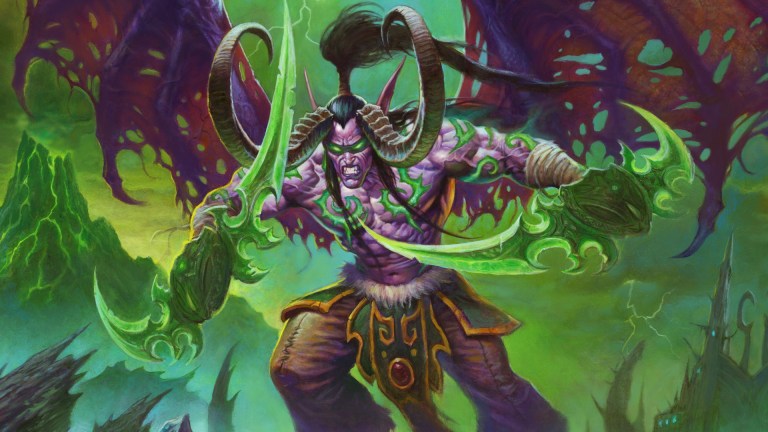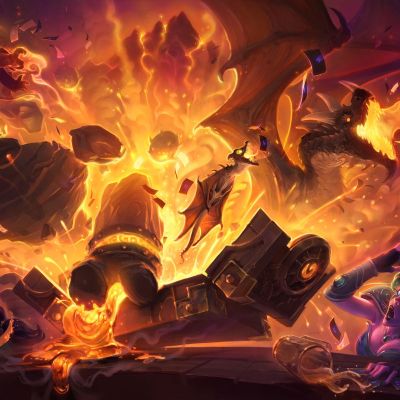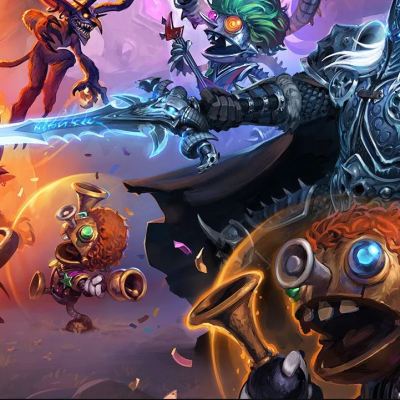Hearthstone Demon Hunter Hands-On Impressions
You are not prepared for the impact of Hearthstone's Demon Hunter class.

The reveal of Hearthstone’s Demon Hunter class is a major game-changer from Blizzard. Not only is this the first new class to be added to Hearthstone since the game’s release, but Demon Hunters have been somewhere near the top of the list of most requested Hearthstone features for a few years now.
Of course, all that anticipation comes with raised expectations. Yes, it’s exciting that Hearthstone is getting a new class, but can Blizzard really ensure that this class is ready to compete on day one?
Well, after spending some hands-on time with the Demon Hunter class during a recent Hearthstone press event, I can confirm that the answer to that question is “Yes, yes, a thousand times, yes.” In fact, in the words of Demon Hunter poster boy Illidan Stormrage, it’s safe to say that Hearthstone players are not prepared for what is to come.
It’s actually difficult to talk about Hearthstone’s Demon Hunter class without talking about Illidan and the rest of the class’ personality. The idea of personality may sound like a minor thing, but as Hearthstone fans know, the style of Blizzard’s CCG has long helped separate it from those who seek to claim the genre crown.
To that end, Demon Hunter feels right at home in this game. While elements of the class’ visual design and card art will no doubt remind some fans of the existing Warlock class, a closer inspection reveals a series of subtle touches that separate Demon Hunters from everything else in the game. Hearthstone fans who love “darker” card art and callbacks to the World of Warcraft lore Hearthstone is based on will immediately fall in love with Demon Hunter’s visuals.
However, I’m not just talking about visuals when I praise the personality of the Demon Hunter class. Not long ago, Blizzard said that it was determined to define and adhere to a class’ “identity” whenever possible. The idea is that every class will have certain strengths and weaknesses that are represented by their cards. The problem is that years of Hearthstone updates may not have fully adhered to the concept of class identity, which means that existing identities have long been somewhat muddled.
Demon Hunter is different. It really feels like the first class that was designed from the ground-up with Blizzard’s idea of class identity in mind.
Nowhere is that more apparent than in the design of the class’ hero power. The Hearthstone team says it played with quite a few different hero power designs before eventually landing on a one-mana ability that grants the Demon Class hero +1 attack. While that hero power may initially sound somewhat underwhelming (even at a somewhat unprecedented one-mana cost) it starts to make a lot more sense once you see how many Demon Hunter cards synergize with your ability to attack on a given turn.
Playing Demon Hunter requires you to constantly be mindful of when you’re able to attack, what cards in your hand and deck best synergize with that ability, and how much health you can safely spend on these attacks. Even weapon-dependent classes like Warrior and Rogue never really forced you to consider resources quite as much as Demon Hunter does.
On top of that, you’ve got the Demon Hunter exclusive (at least for now) Outcast keyword to consider. Outcast cards are incredibly powerful, but you can’t trigger the card’s Outcast effect unless it is the leftmost or rightmost card in your hand. That means that you’re no longer just playing cards in reaction to the state of the board but you also have to consider how the cards you play will help trigger Outcast effects. Yes, you can bet on drawing an Outcast card (which likely puts it in the rightmost spot), but the gamble is just that. Outcast forces you to test how greedy you can be with your deckbuilding and turn-by-turn play.
Put it all together, and I can honestly say that in my limited time with the Demon Hunter class, it felt more “complicated” than other classes in the game currently do. That isn’t to say that new players won’t be able to figure it out, but I was genuinely surprised by how many elements of the class felt like they were designed with veteran players in mind.
I know what you’re really wondering, though. You’re asking, “How powerful is the Demon Hunter class?” While it’s almost impossible to answer that question with absolute certainty until I’ve had a chance to do some real-world testing, my initial answer is “Very, very powerful.”
Some of the statements from Blizzard concerning the Demon Hunter class may lead you to believe that they’re designed to be played as an aggro (aggressive) class. While there are some Demon Hunter cards that are certainly designed with aggro players in mind, other cards are clearly catered towards slower “control” players.
Some of the most powerful Demon Hunter cards I’ve played with so far are the ones that not only allow you to draw quite a few cards but fetch certain cards from your deck and put big minions into play at a reduced cost. There are some cards and interactions that feel a bit overpowered and could soon find themselves as the target of some early nerfs.
Even that is kind of exciting, though. Blizzard is taking a big chance with the addition of this class, and everything from the class’ power level to its release structure could end up blowing up in their face.
As a long-time Hearthstone fan, I’m thrilled to see Blizzard taking a big risk. In its earliest stages, Demon Hunter feels like a pull-no-punches attempt to inject some substantial life into Hearthstone. My initial impression is that Demon Hunter will be quite powerful, but the most exciting thing of all is that this is the first addition to Hearthstone in a long time that feels unpredictable in terms of how it will impact the game as a whole. Instead, we’re all going to have to play, experiment, and figure the class out when it hits the game on April 7.


